#Moroccan Coast
Text

The harmonious blend of cityscape and coastal tranquility at Tangier Beach. Gaze upon the shimmering waters merging with the distant city skyline under a vast azure sky adorned with fluffy clouds. Nature and urban life converge in this captivating scene
#Tangier Beach#Coastal Cityscape#Urban Tranquility#Skyline Photography#Coastal Beauty#Beach Landscape#City Horizon#Waterfront Views#Cloudy Sky#Moroccan Coast#blue sky#skies#clouds#mediterannean sea#sea#hill#Morocco#Tangier#North africa#plants#beach
2 notes
·
View notes
Text

0 notes
Text
Do we all agree a modern AU Gale would wear hella sweaters?
#bg3 gale#gale of waterdeep#i haven't gotten to waterdeep yet#but seeing as his casual fit looks lowkey Moroccan and his last name is Dekairos#i have to assume he's Mediterranean or even specifically Greek or something#which 1. makes him even hhhhhhotter as a Mediterranean babe myself#and 2. so many headcanons about baby getting cold because he's used to the warmer coast so yes hella sweaters#and an appreciation of a solid warming or fire spell
18 notes
·
View notes
Text
This dude who’s doing a project on the ways asian representation connects to gendered social problems or whatever just said he wishes south asians weren’t grouped with asians because they are different…..pardon? It’s wild how someone will be talking about racism and still be racist
#ah yes everyone knows how similar the Spaniards are to the Lithuanians#or how very much alike the aboringal ppls of the southern west North American coast are to the Iroquois….or Moroccans to#to Zambia 😐#bitch China alone has so many micro communities w various languages??? if ur korean….what similarities do you share other than continental#with idk someone in Thailand…the difference you’re referencing is appearance
3 notes
·
View notes
Text

Moroccan Lamb Stew
By: Cynara
Olympia, WA
#green coast livin#corxandforx#legal life#pnw#photography#mine#wa#oly#south sound#stew#soup#moroccan#lamb#foodie#nom nom#eat local#support small business
4 notes
·
View notes
Text
Twisted wonderland nationality headcanons
BTW NONE OF THIS IS CANON I DON'T THINK AND IT'S ALL MY OPINION FEEL FREE TO AGREE OR DISAGREE JUST DON'T HATE ON ME 💔💔💔💔💔
Heartslabyul:
Riddle rosehearts: British
Trey clover: British
Cater diamond: American
Deuce spade: British
Ace trappola: British
__________________________________________
Savanaclaw:
Leona kingscholar: Kenyan
Ruggie bucchi: Kenyan
Jack howl: American
__________________________________________
Octavinelle:
Azul ashengrotto: Danish
Jade leech: Danish
Floyd Leech: Danish
__________________________________________
Scarabia:
Kalim Al asim: Moroccan
Jamil viper: Moroccan
__________________________________________
Pomfiore:
Vil Schonenheit: German
Rook hunt: Ivory coast
Epel felmier: Sámi / Finnish
__________________________________________
Ignihyde:
Idia shroud: Greek
Ortho shroud: Greek
__________________________________________
Diasomnia:
Malleus Draconia: French
Lilia vanrouge: French
Silver: French
Sebek zigvolt: French
__________________________________________
Staff:
Crewel: British
Trein: French
Vargas: Italian
Crowley: French
__________________________________________
other characters:
Neige: Belgian / French
Chenya: British
Rollo: French
__________________________________________
Now for brief explanations:
I hc Most of heartslabyul as British because of Alice in wonderland (Set in Britain) and most of the characters are from the Queendom of roses. I Hc Cater as American because it just fits tbh.
I hc Leona and Ruggie from Kenya because that (allegedly) where the lion king is set in. I hc Jack as american because it fits (x2)
I hc all of octavinelle as Danish because of the little mermaid statue in Copenhagen and the little mermaid movie itself is set in Denmark.
i hc Scarabia as Moroccan because Aladdin is set in a Arabian country (Not said which one specifically) but i chose Morocco because it just felt like it fit.
I hc Vil as German because 1( The evil queen is German 2( Schonenheit is a German name. I hc Rook from ivory Coast because he's canonically from sunset Savanna but I wanted to choose a African country that speaks French as the main language so I picked that. I Hc Epel as Sámi, because I saw a post about how his hometown models a lot after Sámi culture, I hc that he is Sámi from Finland.
I feel like ignihyde is very self explanatory, Idia is based off Hades (Greek god of the underworld) and the Isle of woe resembles Greece
I hc Diasomnia is French only because Sleeping beauty takes place in france.
I hc Neige as Belgian mostly because He's supposed to be snow White (German princess) but his name is in French, And Belgiums main three languages are German, French and dutch.
I hc Crewel as British because he's from the Queendom of roses
I hc Trein as French because it feels right idk
I hc Vargas as Italian because Vargas is a Italian last name (i think)
I hc Crowley as French because im pretty sure he's a fae and probably from briar valley
The others are pretty explanatory I think...?
#twst#twisted wonderland#riddle rosehearts#ace trappola#deuce spade#cater diamond#trey clover#leona kingscholar#jack howl#ruggie bucchi#azul ashengrotto#jade leech#floyd leech#kalim al asim#jamil viper#vil shoenheit#epel felmier#idia shroud#ortho shroud#rook hunt#malleus draconia#lilia vanrouge#silver twst#sebek zigvolt#dire crowley#divus crewel#ashton vargas#mozus trein#sam twst#rollo flamme
60 notes
·
View notes
Text

Sephardi Jewish wedding dress from Morocco, 19th century
Jews have lived in Morocco for thousands of years. Jewish nomadic tribes integrated into all aspects of Moroccan life centuries before the Islamic conquest. During the Spanish Inquisition, the North African coast proved to be an important refuge for persecuted Jews from Iberia, who created a new Moroccan Sephardi identity. Despite religious differences, the proximity of Muslim and Jewish neighbours within Morocco created closely-knit communities, meaning that crafts, customs, culture, art and language were constantly exchanged. Much of the traditional Moroccan culture actually traces its origins to the Moroccan Jewish community.
387 notes
·
View notes
Text
Thinking about the Holocaust in Africa.
Here, European notions of anti-Blackness and antisemitism became intertwined.
There was a fusion between the dispossession and racism of European imperialism and colonization projects of the late nineteenth century, and the prison regimes imposed by European fascism in the early twentieth century.
Scholars Sarah Abrevaya Stein and Aomar Boum have recently written much about the importance of recognizing the trauma of labor and internment camps in North Africa during the second world war.
And I want to express my gratitude for their work. I want to share some of what they’ve written in a couple of recent articles.
In their words: “Nazism in Europe was underlaid by an intricate matrix of racist, eugenicist and nationalist ideas. But the war – and the Holocaust – appears even more complex if historians take into account the racist and violent color wheel that spun in North Africa.” [1]
France's prison camps in North Africa were filled with Algerians, local Jews, deported European Jews, Eastern European refugees, domestic political dissidents from France, people fleeing fascist Spain, Moroccan residents, Senegalese subjects of French rule, other West Africans displaced by French occupation, and more.
The anti-Blackness and antisemitism that had fueled Europe's colonial expansion was finding new expression in fascist Europe.
---
Seems France is a central antagonist in the story of evolving approaches to empire, racism, and resource extraction.
After their 1940 alliance with the Nazis, the Vichy French government maintained technical control of French colonies across Africa. Beginning in 1940, the French government “alone built nearly 70 such camps in the Sahara.” [1] This was in addition to another six labor camps which the French government built in West Africa (in Senegal, Guinea, and Mali).
---
By the beginning of the twentieth century, French-influenced or -controlled territory in North Africa was home to around 500,000 Jews, many of whom had been living in the region for centuries or millennia, speaking many languages, “reflecting their many different cultures and ethnicities: Arabic, French, Tamazight – a Berber language – and Haketia, a form of Judeo-Spanish spoken in northern Morocco.” [1] The Vichy French government officially stripped North African Jews of formal citizenship and seized their assets.
Then, deporting residents of Europe and political dissidents in “early 1941, the Vichy authorities transferred hundreds of Jewish and non-Jewish refugees, including women and children, to the Saharan labor camps.” [2] Under French rule “in Algeria [...], it was estimated that 2,000-3,000 Jews were interned in camps [...] resulting in a total prisoner population of 15,000-20,000.” [2] France pursued an “unrealized dream of the nineteenth century” [2]: the completion of the Mediterranean-Niger railroad line in the Sahara, a transportation route across the vast desert to connect the prosperous West African port of Dakar with the Mediterranean coast of Algeria.
Meanwhile the “Vichy regime [...] continued racist policies begun by France’s Third Republic, which pushed young Black men from the empire into forced military service,” including forced recruitment from “Senegal, French Guinea, Ivory Coast, Niger and Mauritania; [...] Benin, Gambia and Burkina Faso; and Muslim men from Morocco and Algeria. In these ways, the French carried on a wartime campaign of anti-Blackness and Islamophobia, pairing these forms of racialized hatred from the colonial era with antisemitism. Antisemitism had deep roots in French and colonial history, but it found new force in the era of fascism.” [1]
---
In late 1942, during the Nazi occupation of Tunisia, the SS “imprisoned some 5,000 Jewish men in roughly 40 forced labor and detention camps on the front lines and in cities like Tunis.” [2] The fascist Italian government had been experimenting with racist and anti-Black policy in their colonization of East Africa; these policies were expanded in Libya. Here, “Mussolini ordered the Jews of Cyrenaica moved” as “most of the 2,600 Jews deported [...] were sent to the camp of Giado” while “other Libyan Jews were deported to the camps of Buqbuq and Sidi Azaz.” [2]
---
Stein and Boum describe the diversity of prisoner experience: “In these camps, [...] the complex racist logic of Nazism and fascism took vivid form. Muslims arrested for anti-colonial activities were pressed into back-breaking labor” and “broke bread with other forced workers” including ‘Ukrainians, Americans, Germans, Russian Jews and others [...] arrested, deported and imprisoned by the Vichy regime after fleeing Franco’s Spain. There were political enemies of the Vichy and Nazi regime too, including socialists, communists, union members [...] overseen by [...] forcibly recruited [...] Moroccan and Black Senegalese men, who were often little more than prisoners themselves.” [1]
As Stein and Boum describe it: “Vichy North Africa became a unique site [...] where colonialism and fascism co-existed and overlapped.” [2]
They write: “Together, we have spent a decade gathering the voices of the diverse peoples who endured World War II in North Africa, across lines of race, class, language and region. Their letters, diaries, memoirs, poetry and oral histories are both defiant and broken. They express both faith and despair. All in all, they understood themselves to be trapped in a monstrous machine of fascism, occupation, violence and racism.” [1]
---
[1]: Sarah Abrevaya Stein and Aomar Boum. “80 years ago, Nazi Germany occupied Tunisia - but North Africans’ experiences of World War II often go unheard.” The Conversation. 15 November 2022.
[2]: Sarah Arbevaya Stein and Aomar Boum. “Labor and Internment Camps in North Africa.” Holocaust Encyclopedia online. Last edited 13 May 2019.
566 notes
·
View notes
Text

The Moroccan Coast, 2002
Mickey Crisp
32 notes
·
View notes
Photo
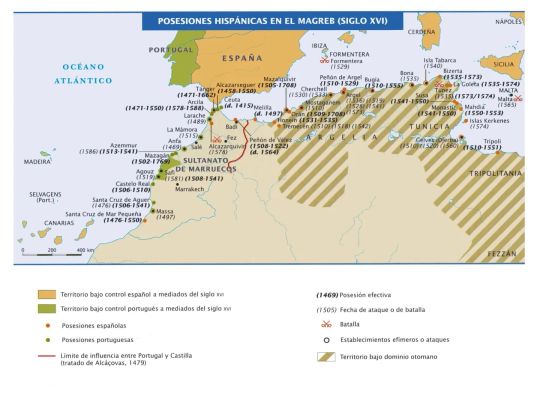
Spanish presidios in northern Africa, 15th-18th century.
“Atlas de Historia de España”, Planeta, 2005
by cartesdhistoire
The presidios were fortresses located along the Mediterranean coast that housed a military garrison. In some cases, Spain entrusted them to vassals, such as Tripoli with the Order of Malta. They were to serve as a base for future Christian expansion into enemy Muslim territory up to the Holy Land. But the presidios soon turned out to be only a strategic issue in the defense of Spanish or Italian coasts, threatened by the Barbary Corsican and Turkish power (also directly attacked as in the campaigns of Kefalonia in 1500, Korón in 1532 or Lepanto in 1571).
According to historian Fernand Braudel, each monarch had a different response. The first was the Fernandina (1492-1516) which was the continuation of the Reconquista: military campaigns in which Pedro Navarro stood out, embodied in the capture of strategic points on the coast from which the nearby towns were controlled. The second was Carolina (1516-1559) which would lead to a gradual decline of the Spanish presence. The absolute ruin of African politics would come in the third stage: the Philippine one (1559-1577), with the failure of Los Gelves (1560) and the loss of Tunisia – including the sacking of the Citadel of Menorca (1558); After the annexation of Portugal in 1580, the king would focus his ambitions on the Ocean.
After the independence of Portugal in 1640, the Ceuta nobles requested to continue belonging to Spain. In 1668 a treaty recognized Spanish sovereignty over Ceuta, including the island of Perejil.
In the middle of the s. XVII, the Moroccan dynasty of the Alawites began the assault of the squares. Only Ceuta, Melilla, the Alhucemas Islands and the Peñón de Vélez remained in Spanish hands in the 19th century. XVIII. In 1774, Melilla was subjected to an unsuccessful three-month siege by Sultan Sidi Mohamed.
The Oranesado remained Spanish for almost three centuries: 1509-1708 and 1732-1791; In 1791, the Councils decided to cede Oran and Mazalquivir.
40 notes
·
View notes
Text


By Sam Metz
September 11, 2023
An earthquake has sown destruction and devastation in Morocco, where death and injury counts continue to rise as rescue crews dig out people both alive and dead in villages that were reduced to rubble.
Law enforcement and aid workers — both Moroccan and international — have arrived in the region south of the city of Marrakech that was hardest hit by the magnitude-6.8 tremor on Friday night and several aftershocks.
Residents await food, water and electricity, and giant boulders now block steep mountain roads.
Here’s what you need to know:
WHAT ARE THE AREAS MOST AFFECTED?
The epicenter was high in the Atlas Mountains about 70 kilometers (44 miles) south of Marrakech in Al Haouz province.
The region is largely rural, made up of red-rock mountains, picturesque gorges and glistening streams and lakes.
For residents like Hamid Idsalah, a 72-year-old mountain guide from the Ouargane Valley, it is unclear what the future holds.
Idsalah relies on Moroccan and foreign tourists who visit the region due to its proximity to both Marrakech and Toubkal, North Africa’s tallest peak and a destination for hikers and climbers.
“I can’t reconstruct my home. I don’t know what I’ll do. Still, I’m alive so I’ll wait,” he said as rescue teams traversed the unpaved road through the valley for the first time this weekend.
The earthquake shook most of Morocco and caused injury and death in other provinces, including Marrakech, Taroudant and Chichaoua.
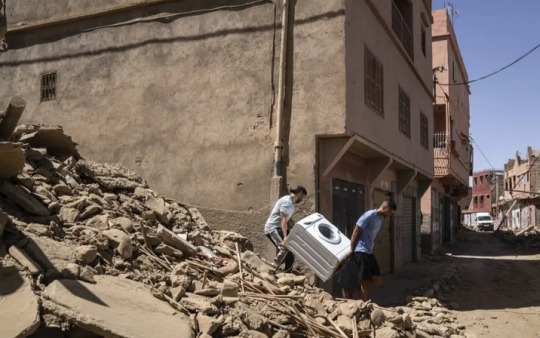
WHO WAS AFFECTED?
Of the 2,122 deaths reported as of Sunday evening, 1,351 were in Al Haouz, a region with a population of around 570,000, according to Morocco’s 2014 census.
People speak a combination of Arabic and Tachelhit, Morroco’s most common Indigenous language.
Villages of clay and mud brick built into mountainsides have been destroyed.
Though tourism contributes to the economy, the province is largely agrarian.
And like much of North Africa, before the earthquake, Al Haouz was reckoning with record drought that dried rivers and lakes, imperiling the largely agricultural economy and way of life.
Outside a destroyed mosque in the town of Amizmiz, Abdelkadir Smana said the disaster would compound existing struggles in the area, which had reckoned with the coronavirus pandemic in addition to the drought.
“Before and now, it’s the same,” said the 85-year-old. “There wasn’t work or much at all.”
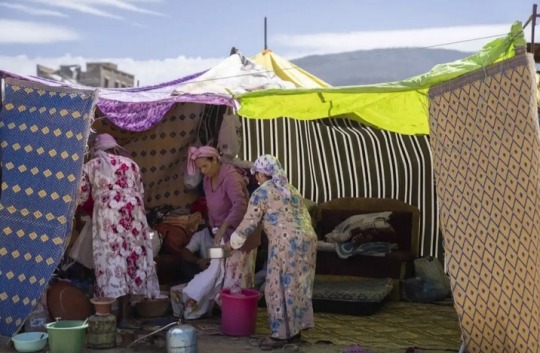
WHO IS PROVIDING AID?
Morocco has deployed ambulances, rescue crews and soldiers to the region to help assist with emergency response efforts.
Aid groups said the government has not made a broad appeal for help and accepted only limited foreign assistance.
The Interior Ministry said it was accepting search and rescue-focused international aid from Spain, Qatar, Britain and the United Arab Emirates, bypassing offers from French President Emmanuel Macron and U.S. President Joe Biden.
“We stand ready to provide any necessary assistance for the Moroccan people,” Biden said Sunday on a trip to Vietnam.
WHY IS MARRAKECH HISTORIC?
The earthquake cracked and crumbled parts of the walls that surround Marrakech’s old city, a UNESCO World Heritage site built in the 12th century.
Videos showed dust emanating from parts of the Koutoubia Mosque, one of the city’s best known historic sites.
The city is Morocco’s most widely visited destination, known for its palaces, spice markets, tanneries and Jemaa El Fna, its noisy square full of food vendors and musicians.

HOW DOES THIS COMPARE TO OTHER QUAKES?
Friday’s earthquake was Morocco’s strongest in over a century but, though such powerful tremors are rare, it isn’t the country’s deadliest.
Just over 60 years ago, the country was rocked by a magnitude-5.8 quake that killed over 12,000 people on its western coast, where the city of Agadir, southwest of Marrakech, crumbled.
That quake prompted changes in construction rules in Morocco, but many buildings, especially rural homes, are not built to withstand such tremors.
There had not been any earthquakes stronger than magnitude 6.0 within 310 miles (500 kilometers) of Friday’s tremor in at least a century, according to the U.S. Geological Survey.
Northern Morocco experiences earthquakes more often, including tremors of magnitude 6.4 in 2004 and magnitude 6.3 in 2016.
Elsewhere this year, a magnitude 7.8 temblor that shook Syria and Turkey killed more than 21,600 people.
The most devastating earthquakes in recent history have been above magnitude 7.0, including a 2015 tremor in Nepal that killed over 8,800 people and a 2008 quake that killed 87,500 in China.
WHAT ARE THE NEXT STEPS?
Emergency response efforts are likely to continue as teams traverse mountain roads to reach villages hit hardest by the earthquake.
Many communities lack food, water, electricity, and shelter.
But once aid crews and soldiers leave, the challenges facing hundreds of thousands who call the area home will likely remain.
Members of the Moroccan Parliament are scheduled to convene Monday to create a government fund for earthquake response at the request of King Mohammed VI.
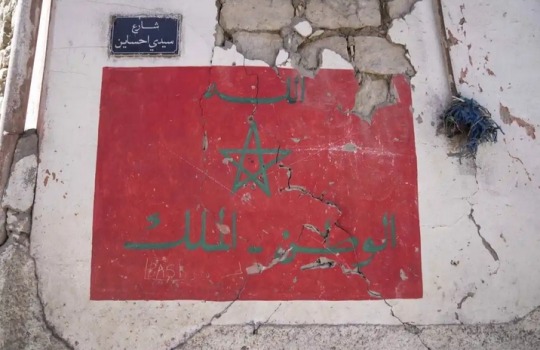
#Morocco#Morocco Earthquake#earthquake#Marrakech#Al Haouz province#Atlas Mountains#Taroudant#Chichaoua#Interior Ministry#Koutoubia Mosque#Moroccan Parliament#King Mohammed VI
93 notes
·
View notes
Text

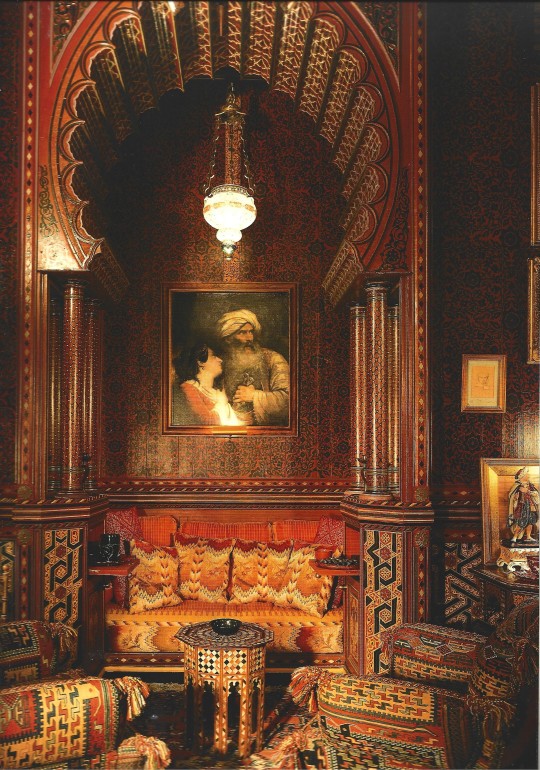






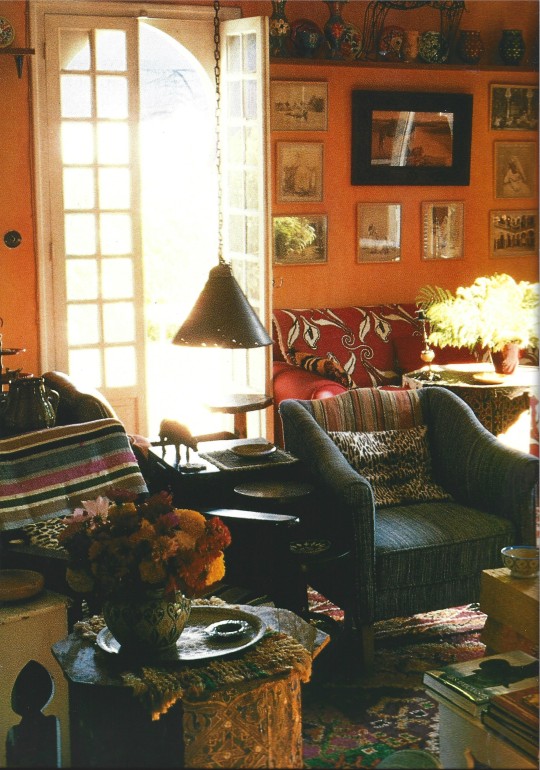
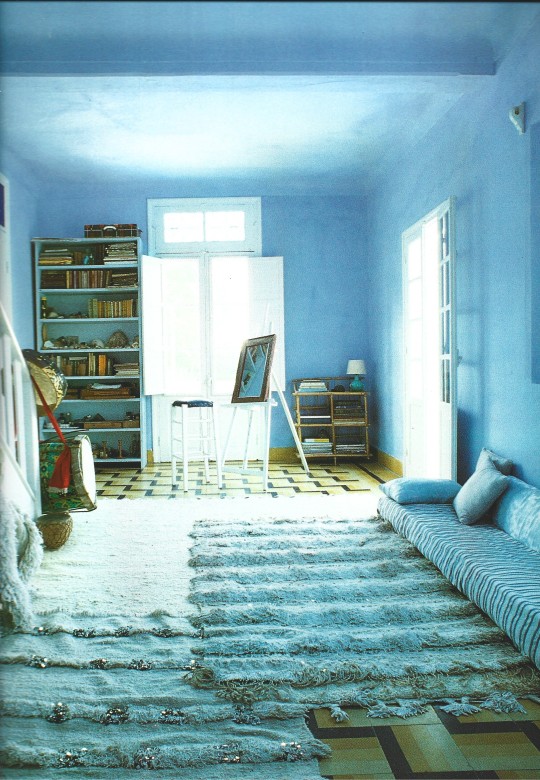
Moroccan Interiors
Lisa Lovatt-Smith, edited by Angelika Muthesius
Photographic co-ordination by Sophie Bausdrand
Benedikt Taschen Verlag, Köln 1998, 320 pages, 24,5x33,8cm, ISBN 3-8228-7656-9 Italian, Spanish, Portuguese
euro 40,00
email if you want to buy : [email protected]
From the Sahara to Tangier on the Mediterranean coast, this book sets out to explore the world of contemporary 'Moroccan Interiors'.
Exploring contemporary interiors in the sun-soaked African nation of Morocco, this breathtaking volume takes readers into the restored palaces in the medinas of Marrakesh as well as humble fishermen's homes at Sisi Moussa d'Aglou.
Cette vue d'ensemble des intérieurs du Maroc nous subjugue comme une visite dans un des nombreux palais de ce pays. Chacune des quarante habitations reproduites ici possède son ambiance individuelle, c'est comme si l'on entrait chaque fois dans une autre pièce : nous passons ainsi des maisons en pisé des villages du sud à l'architecture hispano-moresque des villes impériales, des palais restaurés de la médina de Marrakech aux humbles maisons troglodytes des pêcheurs de Sidi Moussa d'Aglou.
08/10/23
36 notes
·
View notes
Text
A pod of orcas has attacked and sunk another boat in southwestern Europe after relentlessly bombarding the vessel and its crew for almost an hour on Halloween. It is the fourth time that orcas from this region's population have sunk a vessel in the last two years.
On Oct. 31, the Grazie Mamma — a mid-size sailing yacht owned by Polish cruise company Morskie Mile — was attacked by an unknown number of orcas for around 45 minutes oof the coast of Morocco in the Strait of Gibraltar, Morskie Mile representatives wrote in a Facebook post translated from Polish.
The orcas repeatedly hit the yacht's rudder causing major damage and allowing water into the vessel's hull. Despite receiving aid from the Moroccan Navy and being towed toward safety, the boat eventually sank as it entered the port of Tanger-Med in Morocco. All passengers were safely evacuated to rescue boats before the ship sank.
The unusual attack is the latest example of one of many unnerving new orca behaviors that have highlighted the striking intelligence of these deadly predators.
Since 2020, orcas have been regularly harassing boats in the Strait of Gibraltar — a narrow strait between Spain and Morocco that connects the Atlantic Ocean to the Mediterranean Sea — and the surrounding waters off the coast of the Iberian peninsula. (continued)
–
I love them so much 🥰
25 notes
·
View notes
Text


29th January 1850 saw the birth in Muthill of Helen Gloag, who through a series of remarkable events went on to become the Empress of Morocco.
If you have not heard of Helen Gloag, a Scottish woman who became Sultana of Morocco, you are not alone. Her story recently resurfaced.
Helen, a traditional Scottish redhead, was the eldest of Andrew and Anna’s four children. Tragically, Anna lost her mother when she was a child, and her father remarried. Her relationship with her new stepmother was said not to be very good, and as a result, Helen left home when she was just 19-years-old in May 1769 to travel as an indentured servant to the New World – the British colony of South Carolina to be specific.
Helen, who was travelling with some female friends, would not make it to the New World. After sailing for just two weeks, her ship was attacked off the coast of Spain by the Barbary pirates from Morocco. Along with the other women, Helen was taken to a slave market in Algiers in what is today Algeria. The men on the ship were all murdered.
The beautiful green-eyed Scottish woman was sold to a wealthy Moroccan who then handed her over to Sultan Sidi Mohammid ibn Abdullah of Morocco (a member of the Alaouite/Alawi Dynasty that still rules Morocco to this day) as a gift. Due to her beauty, the Sultan added her to his harem. Before long, she became his fourth wife and would go on to be the principal wife who was given the title of Sultana of Morocco.
She was called Lalla Zahra; ‘Lalla’ is a term used in Morocco, ahead of the person’s given name, to show respect and is often used by noble and royal women.
Reportedly, the Sultana was instrumental in convincing the Sultan to have seafarers and slaves, who had been captured by pirates, released. As a favourite of his, she was able to write and send gifts back home to Scotland; the Sultan, who was the first head of state to recognise the United States, even allowed her brother, Robert, to visit her in Morocco on occasion. Robert was responsible for her story being brought back to her homeland.
Sultan Sidi Mohammid died in 1790, and one of his sons, by a German woman in his harem, Yazid took the throne to become Sultan of Morocco. Not wanting to have any competition for the throne, he ordered the killing of his two brothers, who he is said to have been incredibly envious of, by Helen – even though she had attempted to keep them safe by sending them away to a monastery in Tétouan (a town where his first order of business was to persecute the Jews). She reportedly sent out a plea to the British Navy for assistance, but they would not make it to her sons before the new Sultan’s troops would discover and murder both boys.
What exactly happened to the Scottish Sultana of Morocco has never been clear, as nothing was heard from or about her after the death of her sons; however, it has been assumed that she was killed by Yazid or his forces in the two years – known to be full of unrest – after he took the throne.
As I said at the start interest in Helen Gloag only recently peaked thanks to a historical novel based upon her, The Fourth Queen by Debbie Taylor
19 notes
·
View notes
Text
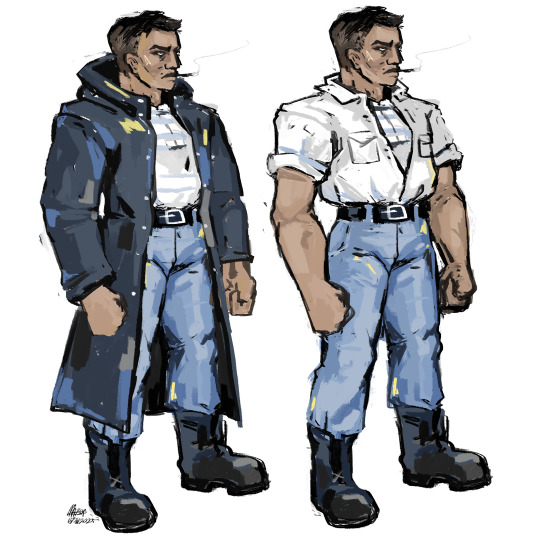

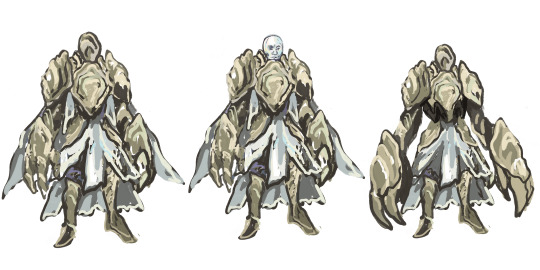
Mate of mine been running a Changeling the Lost campaign so I thought I'd do some concept art of my character Johna. They have a very strong ocean theme, and their mien is based off of an oyster shell.
Johna (they/them)
Age: 65 (apparent age 30-45)
Ethnicity: Greek/Moroccan
Nationality: No longer identifies with any nation (formally Greek)
Seeming: Ogre
Kith: Helldiver
Before, they where a sailor in early 1980s, making their living as a fishermen off the coast of Greece. Then, they where a Helldiver, moulded and shaped to both delve into and survive the crushing depths of Arcadia's oceans, with each dive being pushed to go deeper, and deeper, and deeper. Now, they sail untethered, freely moving from one place to the next, refusing to ever be permanently bound to a place or person again.
Also they work part time at their local Harvey Norman.
Trivia: they chose to take the name 'Johna' as a nod to the way they escaped their keeper: by allowing themselves to be swallowed by a massive whale like creature during a dive and using its mass to snap the silver thread that bound them to their keeper.
#changeling the lost#chronicles of darkness#World of Darkness#digital art#illuistration#concept art#art#drawing#oc: johna
52 notes
·
View notes
Text


Inside ‘Dexter’ Star Michael C. Hall’s Killer New York City Digs
Designer Sara Bengur helped the actor and his wife, Morgan, create the color-drenched home of their dreams.By Ingrid Abramovitch and Styled by Anita SarsidiPublished: Oct 11, 2023
Since founding her firm in 1993, New York–based interior designer Sara Bengur has won awards for her work and garnered projects from Washington, D.C., to the French West Indies to her native Istanbul. Still, when she heard about the New York Design Center’s Access to Design—a matchmaking program between clients and designers—she decided to give it a try. The last thing she expected was for the first query to come from a celebrity. And to instantly bag the job.

The Paul McCobb chairs are vintage, the 1950s table is Italian, and the Tulu rug is from Double Knot.
But that’s exactly what happened when Michael C. Hall—aka the star behind the TV show Dexter—and his wife Morgan flipped through Bengur’s portfolio. “We wanted something simultaneously sophisticated and playful—and we wanted color!” says Hall, who also fronts an indie band, Princess Goes, that released a new album, Come of Age, on October 6. “Sara’s spaces have an ease and flow that immediately appealed.”
The couple had recently moved from the West Coast to New York City and found an apartment at the El Dorado, a legendary Art Deco cooperative on Central Park West. Both Hall and his spouse are design aficionados who started out trying to decorate their home themselves. But while searching for fabrics and furniture at the design center, they realized they needed guidance. “They went to shop and got overwhelmed,” Bengur says. “I got an email from Michael saying, ‘When can we meet?’ I ran up to the El Dorado, and it was an instant connection. We laugh a lot together. They are both creative and really a joy.”

A vibrant pink pigment painting by Bill Kane contrasts with purple walls. The Richard Schultz chairs for Knoll and the Suzani and Moroccan rug from Double Knot are vintage. The walls are painted in Amorous by Benjamin Moore.Richard Powers
Before the move to New York, the couple had spent a stint in the United Kingdom, where Hall was shooting the Netflix murder-mystery series Safe. While overseas, they had fallen under the spell of English country house decor and wanted to bring a similar approach to their New York classic six apartment. “They loved the casual elegance of British country homes with the florals and patterns and feeling of design elements layered over time,” Bengur says. “And like me, they love color. So we experimented with different color combinations, spending hours on the living room floor with bags and bags of samples and color swatches.”
Tour Michael C. Hall’s Color-Drenched NYC Apartment by Sara Bengur
#michael c. hall#new york#apartment#design#home#decoration#I love this!!#They both have a fine taste#dexter#six feet under#princess goes#actor#el dorado
11 notes
·
View notes